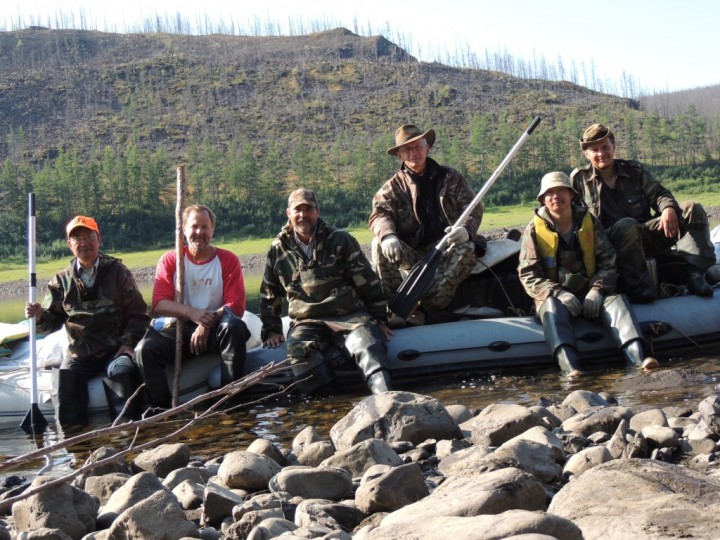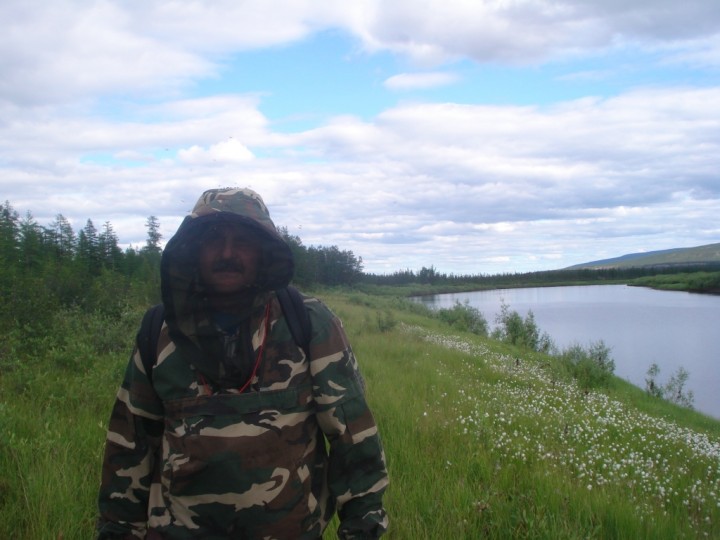Kochechum River 64°42’31’’M 100° 54’ 14’’ E
10:19 p.m. Siberia 10:19 a.m. EDT
79°F High 48°F Low Sunny
Dr. Ranson reports:
We have finally just landed on a camping spot, after a long day on the Kochechum. We spent about hours on the river today. Last night’s camp was about 100 miles upriver – a good day’s journey, by any account.
This morning came early. We were up and working by 7:30, stowed all our gear, had a breakfast, and were on the water by 9:30 in the morning. We have a lot to do before we can roll away from camp, so we really did move fast.

The scientific team on the Kochechum River, pausing for a moment on their race to Tura. From left to right, Guoqing Sun, Ross Nelson, Jon Ranson, Slava Kharuk, Sergei Im and Pasha Oskorbin. Behind the group is a basaltic hill, with a forest killed by fire. A small regeneration is apparent under the dead trees. A band of healthy larch, unburned by fire, lines the river bank.
The biggest news is that the Kochechum is amazingly low. We were here in 2007, and I remember the Kochechum as a very big river, that was fast and high. When we came into the river yesterday, it surprised me. The Kochechum looked small, and the Embenchime looked like the biggest river of the two! The current on the Kochechum is slow, and we are fighting the rocks. We had to pull our boats across at least one area on the Kochechum today. That’s not at all like 2007. This year, the Kochechum is thirsty.
Our campsite, however, is wonderful. It’s actually sandy here. It’s the first night we aren’t sleeping on rocks – that will be really a joy, and I expect to sleep well.
There are some decent looking forests along the Kochechum, with tall trees and dense forest cover. The forests upriver were more scraggly, with fewer trees and apparently slower growth. I’ve noticed that the trees along the river are taller and stronger looking. We’ve seen this all along – that there is robust growth right near the river, but behind the riverside band the forests are thinner, shorter and there are burned areas. The fires do not seem to burn the trees right on the river, but have affected the dryer forest away from the river beds. This far down the Kochechum, the band of healthy forest next to the river is deeper than on the Embenchime, that’s one thing we’ve noticed.
Today we saw our first caribou. We’ve seen moose upriver, but not downriver. And we’ve seen some caribou antlers on the ground upriver, but no living caribou until now.
Just before we came to tonight’s camp, we passed a very large area that seems to have burned very recently. We saw a gray hillside, but we couldn’t see any regrowth. I think we’ll have to carefully look at the MODIS and LANDSAT historical imagery of this area before we return next year, so we can understand when the fires may have occurred, and take a careful look at the land cover from those satellites.

Dr. Jon Ranson, on the Embenchime River earlier in the trip, wears standard mosquito protection. On this trip mosquitoes were ever-present, but not as thick as years past. Instead, green-headed biting flies became a major annoyance.
The weather is brilliant today. Apparently there is high pressure over our heads, so we are in sunshine with no clouds, and no rains. Unfortunately it is very hot. Near 80°F – this is Siberia, not Maryland. It’s surprisingly hot. I don’t know if I recall feeling quite as hot in previous trips, but I don’t know for sure. I can say, however, that the heat is remarkable. When we are boating, we have a 10 km per hour breeze, and that is quite welcome.
There’s not a lot to do when we are well underway, and the water is deep enough that we don’t have to fight the rocks. So we find ways to pass the time. We look at the scenery and make observations. We try to talk, but the motors make enough noise that it is difficult, so mostly we find solitary ways to pass the time.
Guoqing finds a way to enjoy his surroundings, wherever he may be. He has been studying the pebbles around here, and has collected a few interesting ones. As we were traveling downriver today, he arranged his pebbles in an intricate pattern on his boat. It really looks cool – a little art in the wilderness. And it speaks to how much he connects with his surroundings. He’s a very hard worker in the field, and seems to have a good time, all at once.

The scientists were looking forward to reaching the Kochechum River, where they expected water to be deep and current swift, helping push them on their way to Tura. When then arrived at the confluence, however, it appeared that the Embenchime carried more water than the Kochechum. The low waters have made navigation difficult from the first day of their journey.
Ross and I have a different approach to time in the boat. In years past, the mosquitoes have been blood-sucking ferocious, and extremely plentiful. I finally learned to bring a flyswatter along, to use each night in my tent. I could swat away all the buzzing irritants before I tried to sleep. I mentioned this to Ross today, and he immediately wanted to see my flyswatter. So I dug into my gear, and handed it over.
Mosquitoes have not been a huge problem, this year, especially on the river. But we’ve been pestered with green-headed biting flies. I don’t know what they call them, but I know we have had various less-than-friendly names for them. Today, however, we’ve had our revenge. Ross has been primary on the swatter, and seems to enjoy hunting them as we chug downriver. I’ve had my hand in it, too, I have to admit. The flies really should learn to leave this boat alone.
We also did some laundry again today, dragging the clothes between the boats, where the turbulent water acts like a washing machine. I now have nice clean socks and a clean shirt, too, so that when I get to Tura I can look a little respectable.
Sergei and Pasha seem to be good friends, as well as hard working colleagues. They make sure the boats stay in working order, are our primary cooks, and keep the camp running smoothly. At night, I hear them chatting amiably in Russian. I can’t tell what they are talking about, but I get the idea much of it is about their families and their young children. They have a lot in common, and the friendship is evident, in any language.
We all get along well. Despite the hard work, the austere conditions, and the exhaustion we experience from time to time, there has been no fighting, no drama here. We enjoy each other, enjoy our work, and manage to have a good time, when the opportunity arises.
I just got the call to join dinner. We’ll eat, then head to bed. Tomorrow we will leave here early, and plan to forge on to Tura, no matter how long it takes. The prospect of a hot shower and a soft bed is quite appealing – we’re ready return to civilization.




Great shots! Fantastic to read about this work to put some sense of reality back to the general climate conversation in mass media. And fantastic voyage 🙂 Keep it up!
It’s neat to think that you have to think of looking up historical satellite data to figure out when a large forest fire occurred. Not like the recent fires in the US 🙂 By the way, this gave me the urge to check out the river on Google Maps and quickly after that I went to Google Earth and was trolling up and down watersheds all over eastern Russia! It’s very neat to think that you have to check historical satellite imagery to The world is an amazing place.